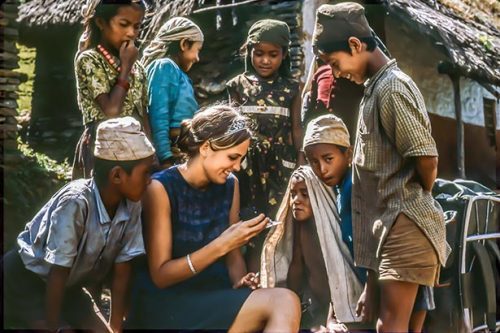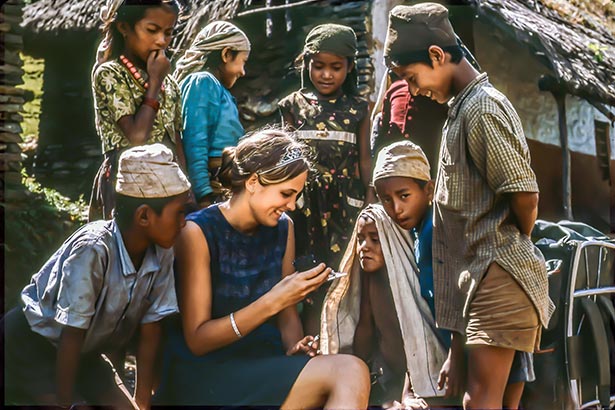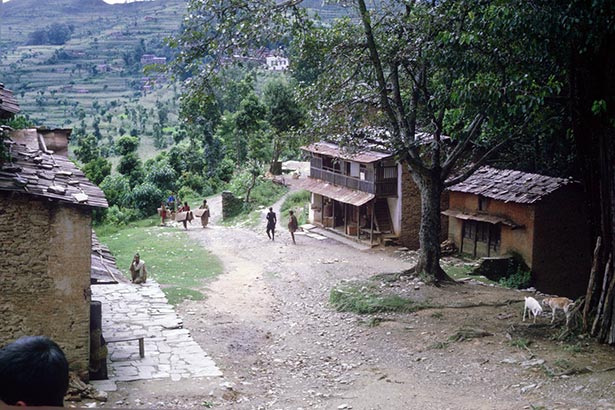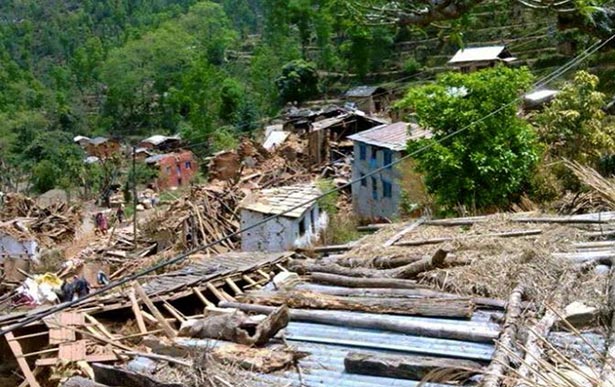
Earthquake day in Nepal minus one — 2 pm Friday, April 24, I’m in a coffee shop in Berkeley. I hit the “send” button on a newsletter to my fellow Nepal 7 RPCV’s (Returned Peace Corps Volunteers) for our 50th reunion in August. My husband, Tom, and I are visiting here from Eugene to attend a dinner for retired Berkeley cops (my husband’s career) and to visit our son’s family. An hour later, 46 out of 76 have opened the newsletter. Success!
Earthquake day one in Nepal — 9 am Saturday, April 25, I’m enjoying a wonderful dream, when my son knocks on our door. “Wake up, Mom … Nepal … 7.8 earthquake … Kathmandu devastated.” What? What!
No time to find out more as our daughter-in-law Candice ferries me to 9-year-old granddaughter Soli’s softball game. I watch Soli come to bat — her stance ferocious — while I read all I can find about the earthquake on my iPhone. Tom slides in beside me on the bleachers. “What’s new?” he says. “Soli had a base hit,” I say. “There are 1,200 dead in Kathmandu.”
Candice returns and gives us directions to the next game — T-ball at another playing field. We watch 6-year-old Dax hit the ball off the top of the post and run to first. He steals second! My cell phone rumbles. Email from my post-mate in Nepal, Bob Swanick. He is distraught.
 |
| Vicki Elmer with villagers of Tukche looking at a compass, 1966. Photo by Jim Sarracino. |
In 1965, Bob and I were stationed in Chautara, capital of the Sindhu Palchok District. Chautara was a small village of 200 people located on a ridge halfway between Kathmandu and the northern Tibetan border. It took us a day and a half to walk there from Kathmandu. I taught science, and he started a chicken farm. My next door neighbors “adopted” me and I hung out with my “sister.”
When Bob and I saw each other again last fall for the first time in over 30 years, we talked about how our village had grown into a thriving bazaar of 3,000, and about going back to visit with our spouses.
I now tug at Tom’s sleeve as we watch the baseball game. “Tom,” I say, “there’s going to be very little left of Chautara.” Most of the houses that I knew, including the one I lived in, were made of mud and stone that would have collapsed during the quake and aftershocks.
Tom and I meet our son, daughter-in-law and grandchildren for lunch. I am distracted. I sneak a few pieces of the kids’ cornmeal pancakes as I check the New York Times on my iPhone. Death toll is now 2,000. We will meet Anya, the 12-year-old, at a high school baseball field. Anya is the catcher and helps to tag someone out. Tom and I escape sports and arrive at our favorite Berkeley coffee shop.
At last! I open up my computer, grateful for the internet. One email from my sister who hiked to Everest Base Camp last year. Another from the husband of another sister who is also a returned Nepal PCV. Both reaching out with love and compassion. I email others in my group. My best friend in Nepal married another Nepali Peace Corps Volunteer, and their son now teaches in Kathmandu. They’ve spent half the year in Nepal for the past 10 years. I hope for the best.
I receive a request from a professor at the University of Colorado for help with crowdsource mapping of Kathmandu for the emergency workers. I’m excited! I’m a planner. I can help! But as I get into the details, I realize it is beyond me. I feel old and helpless. We return to our son’s house, dress and leave for the retiree’s dinner. The death toll is now close to 3,000 and I need a glass of wine.
I immediately encounter a tall Berkeley Police Department retiree who was a Peace Corps volunteer before he became a cop, and we hug. The wife of a retired homicide inspector reaches for my hand and says, “I know you want to be there to help.” I talk with a newspaper reporter married to one of the retirees who says, “Writing helps.” I drink too much and take aspirin before going to sleep.
 |
| A street scene in the village of Chautara, 1968, Photo by Kate R.H. |
 |
| Chautara after the earthquake |
Earthquake day two in Nepal. Sunday, April 26, we return home to Eugene as the death toll continues to rise. Rescuers haven’t even begun to reach the villages outside the Kathmandu Valley. The prime minister in Nepal projects 10,000 dead. I am blue, and feeling stupid that I can’t even help with the crowdsource mapping.
Earthquake day three in Nepal. Monday, April 27, after class at the University of Oregon, where I teared up in front of my students, a colleague forwards a blog from a former Nepali Ph.D. student. He is in Nepal and has organized Nepali students to do the crowdsource mapping. Their map of tent cities was picked up by The New York Times! The blog pulses with excitement. It balances the terrible news about the deaths and destruction. I click through and donate $30. It is such a small thing, but makes me feel better.
Earthquake day five in Nepal. Thursday, April 30. Two days pass. The Nepali Times interviews a teacher in a small village near Chautara whose school collapsed with many students inside. Other news shows total devastation. The proud village of Chautara needs water, food and sanitary facilities. My heart just hurts.
Then I get an email from one of the Nepali language teachers for our group who is from the epicenter of the earthquake. “We are strong,” he writes. “We have courage! We will survive!”
I also hear from my friend whose son is in Nepal (and is OK). She writes, “What has been most impressive is the presence of the youth — buying supplies, loading trucks to make deliveries to remote areas. These are often private, individual initiatives; their presence is powerful and significant … not only has there been an incredible outpouring of support from outside Nepal but within the country as well.”
My heart is still heavy but I am cheered. And, my journalist friend is right, writing helps. — Vicki Elmer